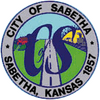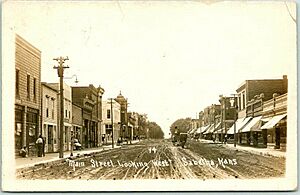Sabetha, Kansas facts for kids
Quick facts for kids
Sabetha, Kansas
|
||
|---|---|---|
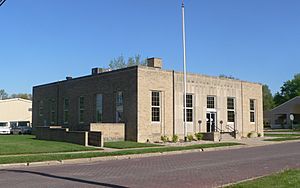
US Post Office in Sabetha (2015)
|
||
|
||
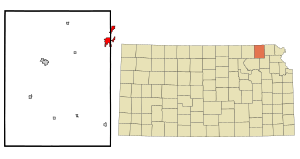
Location within Nemaha County and Kansas
|
||
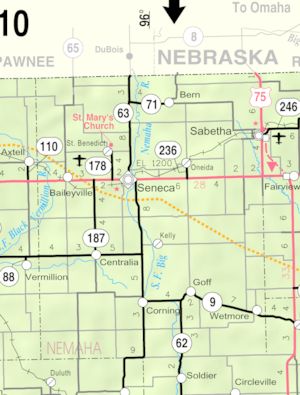
|
||
| Country | United States | |
| State | Kansas | |
| Counties | Brown, Nemaha | |
| Founded | 1854 | |
| Incorporated | 1874 | |
| Named for | Sabbath | |
| Area | ||
| • Total | 3.20 sq mi (8.30 km2) | |
| • Land | 3.19 sq mi (8.26 km2) | |
| • Water | 0.01 sq mi (0.03 km2) | |
| Elevation | 1,273 ft (388 m) | |
| Population
(2020)
|
||
| • Total | 2,545 | |
| • Density | 795.3/sq mi (306.63/km2) | |
| Time zone | UTC−6 (CST) | |
| • Summer (DST) | UTC−5 (CDT) | |
| ZIP Code |
66534
|
|
| Area code | 785 | |
| FIPS code | 20-62025 | |
| GNIS ID | 485648 | |
Sabetha is a city in the state of Kansas, USA. It is located in both Brown and Nemaha counties. According to the 2020 census, about 2,545 people live in Sabetha.
Contents
A Look at Sabetha's History
Sabetha started as a settlement around 1854. People say its name comes from "Sabbath," which is a day of rest. This is because the first person to settle there arrived on that day. Sabetha officially became a city in 1874.
The 1998 Tornado Event
On the evening of June 13, 1998, a strong tornado hit Sabetha. It was an F2 tornado, which means it was quite powerful. The tornado caused a lot of damage in the downtown area. Luckily, no one was hurt.
The tornado struck very quickly, giving people less than a minute of warning. It started about half a mile west of the Sabetha City Hall. It badly damaged two blocks of the town. Eighteen buildings in the downtown area were damaged. Five of these buildings, including the city hall, were almost completely destroyed. The tornado then moved about half a mile east of City Hall before it lifted. The damage to the city hall building alone cost about $2 million. Homes and cars outside the downtown area also had damage from falling trees and strong winds.
Sabetha's Location and Size
Sabetha is located in Kansas. The United States Census Bureau measures the city's total area. It covers about 3.47 square miles (8.30 square kilometers). Most of this area is land, about 3.46 square miles (8.26 square kilometers). A very small part, about 0.01 square miles (0.03 square kilometers), is water.
Who Lives in Sabetha?
| Historical population | |||
|---|---|---|---|
| Census | Pop. | %± | |
| 1880 | 849 | — | |
| 1890 | 1,368 | 61.1% | |
| 1900 | 1,646 | 20.3% | |
| 1910 | 1,768 | 7.4% | |
| 1920 | 2,003 | 13.3% | |
| 1930 | 2,332 | 16.4% | |
| 1940 | 2,241 | −3.9% | |
| 1950 | 2,173 | −3.0% | |
| 1960 | 2,318 | 6.7% | |
| 1970 | 2,376 | 2.5% | |
| 1980 | 2,297 | −3.3% | |
| 1990 | 2,341 | 1.9% | |
| 2000 | 2,589 | 10.6% | |
| 2010 | 2,571 | −0.7% | |
| 2020 | 2,545 | −1.0% | |
| U.S. Decennial Census | |||
Population Facts from 2010
In 2010, the census showed that 2,571 people lived in Sabetha. There were 1,090 households, which are groups of people living together. About 645 of these were families. The city had about 743 people per square mile.
Most of the people in Sabetha were White (96.6%). A smaller number were African American (0.9%), Native American (0.5%), or Asian (0.1%). Some people were from other races or had mixed backgrounds. About 1.0% of the population was Hispanic or Latino.
In terms of households, 27.4% had children under 18 living there. Nearly half (49.4%) were married couples. About 40.8% of households were not families. Many people (37.2%) lived alone. About 20.5% of households had someone aged 65 or older living by themselves. The average household had 2.24 people. The average family had 2.97 people.
The average age in Sabetha was 42.8 years old. About 25% of residents were under 18. About 24.2% were 65 years or older. The city had slightly more females (52.5%) than males (47.5%).
Sabetha's Economy and Jobs
Sabetha has more jobs available than people living there. This is partly because of large companies like Wenger Manufacturing. Wenger makes special machines called extruders and related equipment. Another big employer is Coperion (formerly MAC Equipment). They make equipment for handling materials and cleaning air. Other important companies in the area include KSi Conveyors and USC.
City managers believe Sabetha has nearly 5,000 jobs. This is twice the number of its residents. Many people from smaller towns nearby travel to Sabetha for work. These smaller towns are often called "bedroom communities" because people live there but work elsewhere.
Education in Sabetha
Students in Sabetha attend schools in the Prairie Hills USD 113 public school district. This school district was created in 2010. It was formed when two older districts, Sabetha USD 441 and Axtell USD 488, joined together.
Famous People from Sabetha
- Wilbur Bestwick (1911–1972): He was the very first Sergeant Major of the United States Marine Corps.
- Arthur Schabinger (1889–1972): A well-known basketball coach and administrator. He is a member of the Basketball Hall of Fame.
- Krishna Shenoy: A smart neuroscientist and neuroengineer. She was a professor at Stanford University.
See also
 In Spanish: Sabetha (Kansas) para niños
In Spanish: Sabetha (Kansas) para niños


